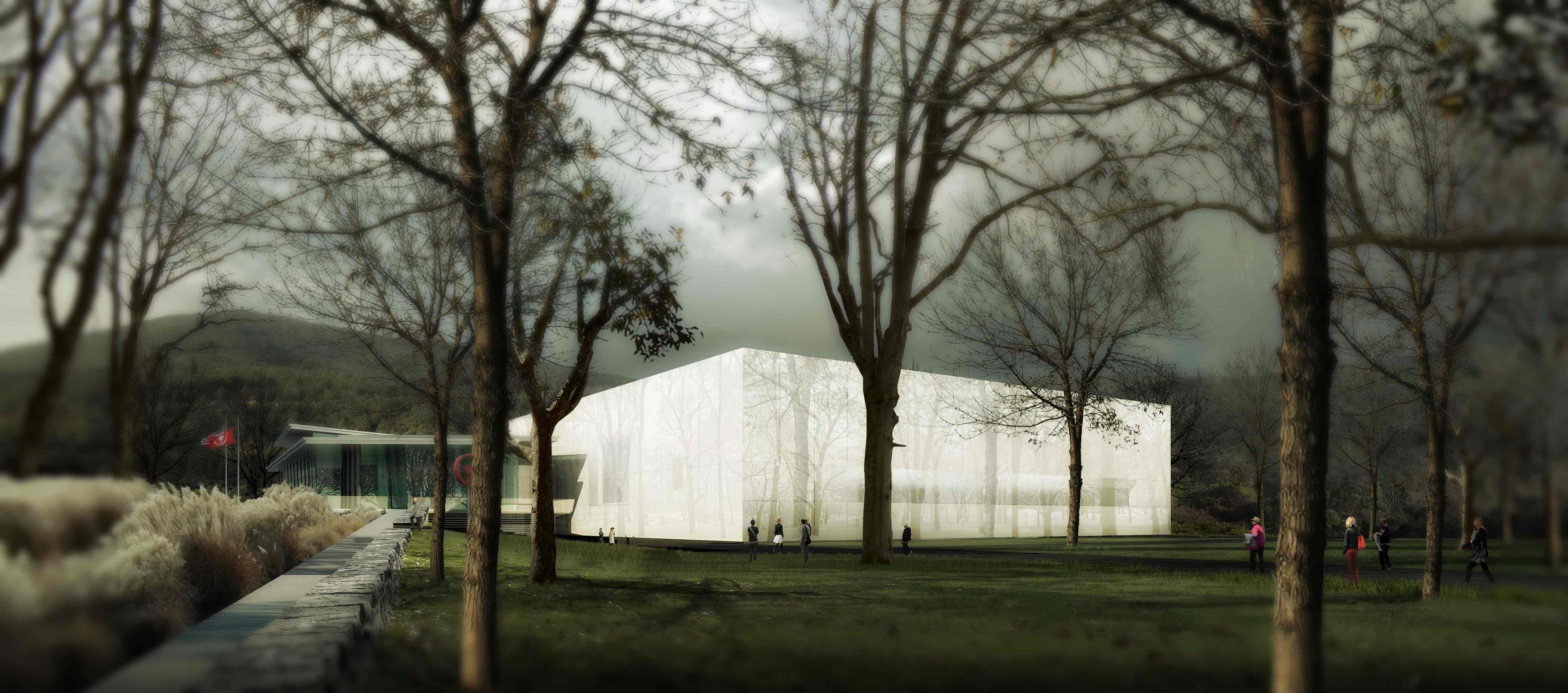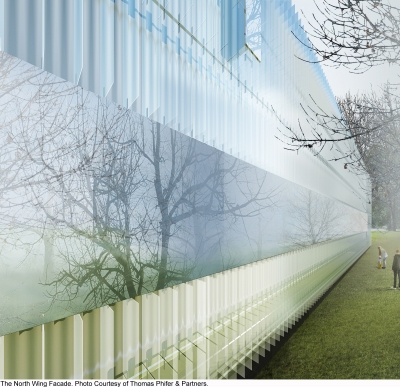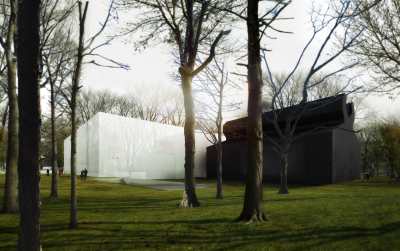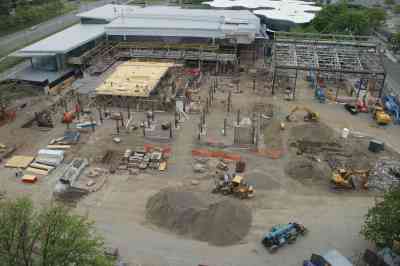 The final design for the exterior of new contemporary-art wing of The Corning Museum of Glass. courtesy: the corning museum of glass
The final design for the exterior of new contemporary-art wing of The Corning Museum of Glass. courtesy: the corning museum of glass
One year ago, the initial design for the new North Wing of The Corning Museum of Glass was unveiled at a press conference at the offices of the architect, Thomas Phifer and Partners. The proposed design for the exterior mixed reflective panels that bounced the image of surrounding greenery with sharp vertical blades that referenced the glass art of Josepha Gasch-Muche among others. One year later, the design has been finalized, and there’s been a striking shift away from the edgy initial proposal, to an almost-opaque glass box that offers soft reflections of the trees and a hovering glow at dusk.
 The original proposal called for vertical blades of glass overlaid with reflective panels. courtesy: thomas phifer and partners
The original proposal called for vertical blades of glass overlaid with reflective panels. courtesy: thomas phifer and partners
When asked by the GLASS Quarterly Hot Sheet about this significant revision in the design, and the only major revision from what was initially presented in June 2012, Thomas Phifer said that the complexity of the initial concept was “rethought” as there was new consideration of “what the nature of this building was … as a kind of container of contemporary art.”
“The blades are gone, all of that complexity has been taken away, it really lives in this world,” says Phifer, who now cites the work of contemporary artists such as Dan Graham and Larry Bell as inspiration for the new approach to the exterior. The new design features a gently reflective glass that offers a soft view of the surrounding landscape thanks to a white sheet interlayer in the glass panels. “It’s very pure and simple,” Phifer continues, “a kind of vitrine.”
Asked what prompted the revision, Phifer says, “We have been influenced by the art, by Tina [Oldknow, curator of modern glass], Karol [Wight, executive director of the museum], and by a whole host of thoughts. It’s hard to separate us from them, we’ve become so involved with realizing this project.”
 The new glass-clad 26,000-square-foot gallery building, will contrast sharply with a new 500-seat glassmaking demonstration venue, a metal-clad reuse of the former Steuben Glass factory ventilator building. courtesy: the corning museum of glass
The new glass-clad 26,000-square-foot gallery building, will contrast sharply with a new 500-seat glassmaking demonstration venue, a metal-clad reuse of the former Steuben Glass factory ventilator building. courtesy: the corning museum of glass
Corning Museum executive director Karol Wight told the Hot Sheet that the subtle mirror-effect of the new building is a reminder of the material from which it is constructed. “I love the fact that it has this reflectivity on the outside, helping viewers realize it’s glass, and not some white wall surface.” Now that the exterior has been finalized, Wight says that the focus is now shifting to the inside, where Tina Oldkow has been arranging how the objects will be displayed. “She is moving toward a thematic arrangement of the objects, and it’s become a wonderful endpoint to the history of glass as you move through the building.” Wight also points out that the new exterior surface will allow it to better receive projections of light for possible use in outdoor works.
Before Wight came to Corning, she had been the senior curator of antiquities at the Getty Villa, and helped shape a completely new presentation of the collection. “What’s been different is the number of voices in the mix,” Wight said. “We have been working with a single curator, Tina, versus six different curators, all invested in changing the museum.”
 The construction site where the new North Wing of The Corning Museum is taking shape. courtesy: the corning museum
The construction site where the new North Wing of The Corning Museum is taking shape. courtesy: the corning museum
Architect Gabriel Smith, a director at Phifer and Partners, said the project is on schedule to open in late 2014, that all of the form work is in place and it’s possible to get a sense of the building’s scale already. The specialized glass exterior cladding is being fabricated in Germany. At 10 1/2-feet wide and in lengths of up to 26-feet, only a handful of companies in the world could make such large-scale panels for such a visually demanding application — any blemishes would ruin the effect. The logistics involved in shipping the glass from Germany, and then trucking them from New York Harbor, are daunting, with the thickness of the glass panels determined in part by stresses endured during transportation.
“This has been the most demanding use of glass our firm has worked with,” says Phifer. “I think that’s what’s wonderful about the simplicity of the design; it complements the legacy of pushing glass forward, which is what Corning is all about, pushing the technology.”


